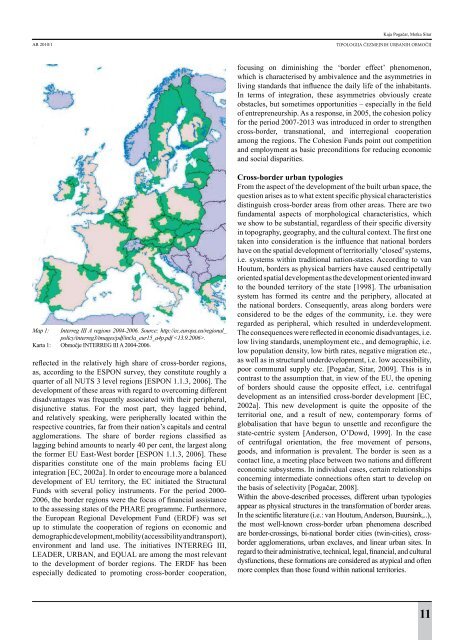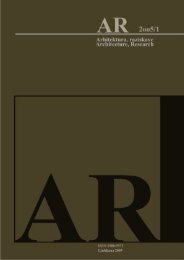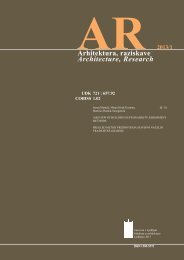AR 2010/1 - Fakulteta za arhitekturo - Univerza v Ljubljani
AR 2010/1 - Fakulteta za arhitekturo - Univerza v Ljubljani
AR 2010/1 - Fakulteta za arhitekturo - Univerza v Ljubljani
You also want an ePaper? Increase the reach of your titles
YUMPU automatically turns print PDFs into web optimized ePapers that Google loves.
Kaja Pogačar, Metka Sitar<br />
<strong>AR</strong> <strong>2010</strong>/1<br />
TIPOLOGIJA ČEZMEJNIH URBANIH OBMOČIJ<br />
focusing on diminishing the ‘border effect’ phenomenon,<br />
which is characterised by ambivalence and the asymmetries in<br />
living standards that influence the daily life of the inhabitants.<br />
In terms of integration, these asymmetries obviously create<br />
obstacles, but sometimes opportunities – especially in the field<br />
of entrepreneurship. As a response, in 2005, the cohesion policy<br />
for the period 2007-2013 was introduced in order to strengthen<br />
cross-border, transnational, and interregional cooperation<br />
among the regions. The Cohesion Funds point out competition<br />
and employment as basic preconditions for reducing economic<br />
and social disparities.<br />
Map 1: Interreg III A regions 2004-2006. Source: http://ec.europa.eu/regional_<br />
policy/interreg3/images/pdf/int3a_eur15_a4p.pdf .<br />
Karta 1: Območje INTERREG III A 2004-2006.<br />
reflected in the relatively high share of cross-border regions,<br />
as, according to the ESPON survey, they constitute roughly a<br />
quarter of all NUTS 3 level regions [ESPON 1.1.3, 2006]. The<br />
development of these areas with regard to overcoming different<br />
disadvantages was frequently associated with their peripheral,<br />
disjunctive status. For the most part, they lagged behind,<br />
and relatively speaking, were peripherally located within the<br />
respective countries, far from their nation’s capitals and central<br />
agglomerations. The share of border regions classified as<br />
lagging behind amounts to nearly 40 per cent, the largest along<br />
the former EU East-West border [ESPON 1.1.3, 2006]. These<br />
disparities constitute one of the main problems facing EU<br />
integration [EC, 2002a]. In order to encourage more a balanced<br />
development of EU territory, the EC initiated the Structural<br />
Funds with several policy instruments. For the period 2000-<br />
2006, the border regions were the focus of financial assistance<br />
to the assessing states of the PH<strong>AR</strong>E programme. Furthermore,<br />
the European Regional Development Fund (ERDF) was set<br />
up to stimulate the cooperation of regions on economic and<br />
demographic development, mobility (accessibility and transport),<br />
environment and land use. The initiatives INTERREG III,<br />
LEADER, URBAN, and EQUAL are among the most relevant<br />
to the development of border regions. The ERDF has been<br />
especially dedicated to promoting cross-border cooperation,<br />
Cross-border urban typologies<br />
From the aspect of the development of the built urban space, the<br />
question arises as to what extent specific physical characteristics<br />
distinguish cross-border areas from other areas. There are two<br />
fundamental aspects of morphological characteristics, which<br />
we show to be substantial, regardless of their specific diversity<br />
in topography, geography, and the cultural context. The first one<br />
taken into consideration is the influence that national borders<br />
have on the spatial development of territorially ‘closed’ systems,<br />
i.e. systems within traditional nation-states. According to van<br />
Houtum, borders as physical barriers have caused centripetally<br />
oriented spatial development as the development oriented inward<br />
to the bounded territory of the state [1998]. The urbanisation<br />
system has formed its centre and the periphery, allocated at<br />
the national borders. Consequently, areas along borders were<br />
considered to be the edges of the community, i.e. they were<br />
regarded as peripheral, which resulted in underdevelopment.<br />
The consequences were reflected in economic disadvantages, i.e.<br />
low living standards, unemployment etc., and demographic, i.e.<br />
low population density, low birth rates, negative migration etc.,<br />
as well as in structural underdevelopment, i.e. low accessibility,<br />
poor communal supply etc. [Pogačar, Sitar, 2009]. This is in<br />
contrast to the assumption that, in view of the EU, the opening<br />
of borders should cause the opposite effect, i.e. centrifugal<br />
development as an intensified cross-border development [EC,<br />
2002a]. This new development is quite the opposite of the<br />
territorial one, and a result of new, contemporary forms of<br />
globalisation that have begun to unsettle and reconfigure the<br />
state-centric system [Anderson, O’Dowd, 1999]. In the case<br />
of centrifugal orientation, the free movement of persons,<br />
goods, and information is prevalent. The border is seen as a<br />
contact line, a meeting place between two nations and different<br />
economic subsystems. In individual cases, certain relationships<br />
concerning intermediate connections often start to develop on<br />
the basis of selectivity [Pogačar, 2008].<br />
Within the above-described processes, different urban typologies<br />
appear as physical structures in the transformation of border areas.<br />
In the scientific literature (i.e.: van Houtum, Anderson, Buursink,..),<br />
the most well-known cross-border urban phenomena described<br />
are border-crossings, bi-national border cities (twin-cities), crossborder<br />
agglomerations, urban exclaves, and linear urban sites. In<br />
regard to their administrative, technical, legal, financial, and cultural<br />
dysfunctions, these formations are considered as atypical and often<br />
more complex than those found within national territories.<br />
11

















